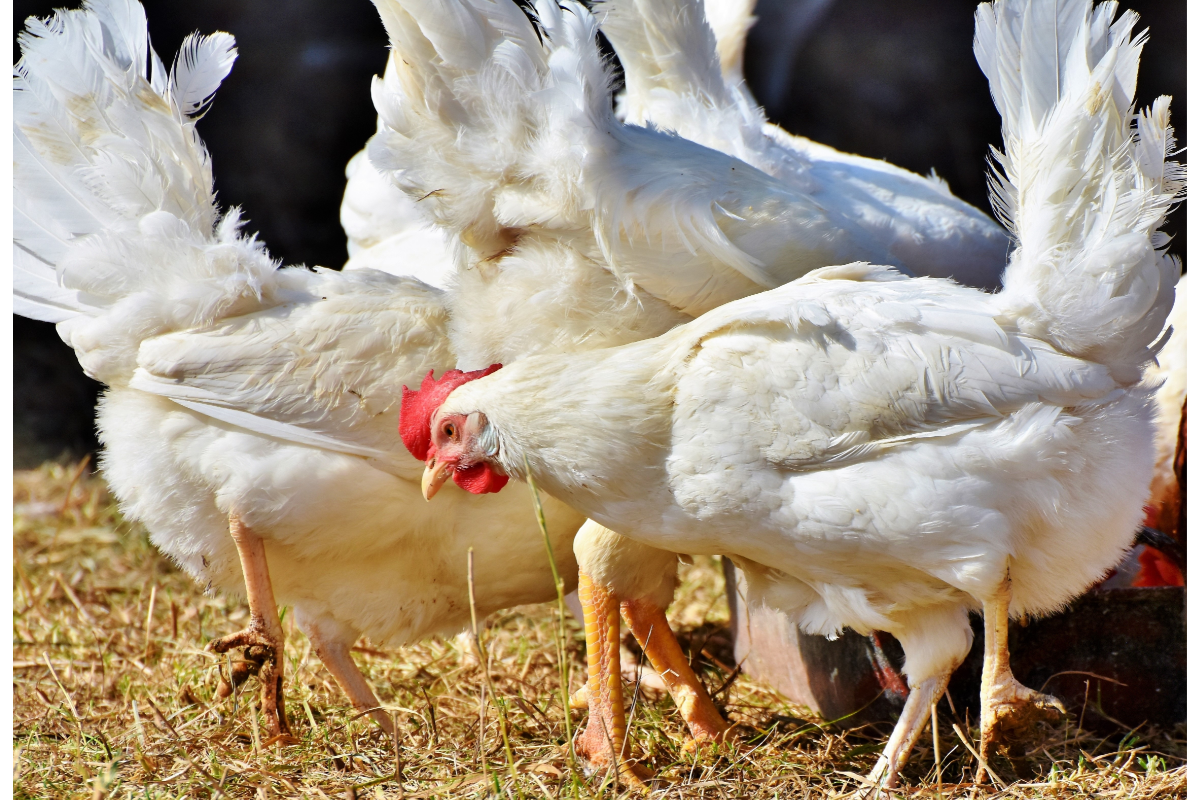Campylobacteriosis is a major public health problem. It is one of the most frequently reported food-borne zoonoses in Europe. With an estimated incidence of around 842 cases per 100,000 inhabitants per year in France, these bacterial infections pose significant public health challenges. Although campylobacteriosis is not a notifiable disease in humans, clustered cases associated with the consumption of the same food require a compulsory declaration of collective food poisoning.
What is the infectious agent?
Campylobacter (from the Greek καμπύλος, curve) is a genus of Gram-negative, microaerophilic, oxidase-positive, non-spore-forming bacteria involved in food poisoning. They mainly reside in the intestinal tract of various animals, particularly those bred in captivity. They are recognised as a source of zoonoses in livestock farming. They are also the main bacterial cause of human gastroenteritis worldwide. This prevalence is increasing in developed countries, potentially as a result of animal concentration.
These bacteria, with their demanding growth conditions, come in a variety of forms. In particular, slightly curved or even spiral-shaped bacilli are found in juvenile cultures, and coccobacillary bacilli in more mature cultures. They are grown on Columbia blood agar in microaerophilic conditions.
The genus Campylobacter comprises 17 species. The main species are C. jejuni and C. coli, which cause enteritis, and C. fetus, which causes septicaemia in immunocompromised individuals. The clinical manifestations induced by these bacteria vary. The main symptoms are enteritis, with diarrhoea, fever and abdominal pain occurring after an incubation period of two to five days. Less frequent post-infectious complications can also occur, including reactive arthritis and Guillain-Barré syndrome.
A. fetus rarely causes enteritis. On the other hand, it most often causes prolonged febrile syndromes with focal damage, mainly to the vascular endothelium. C. fetus infections generally occur in individuals with underlying pathologies such as cirrhosis, cancer, diabetes or immunodeficiency. Infection with C. fetus during pregnancy carries a high risk of foetal death.
Other species of Campylobacter cause various infections, such as Campylobacter upsaliensis, Campylobacter lari and Campylobacter hyointestinalis. The main reservoir of these bacteria is animal, comprising a variety of birds and mammals, with chickens in particular being the natural reservoir of C. jejuni.
What does the disease look like in animals?
Cases of Campylobacter jejuni and Campylobacter coli infection are widespread throughout the world. Poultry are the main carriers of these bacteria. Symptoms generally associated with these infections often include diarrhoea, although some carriers, such as poultry and pigs, may remain asymptomatic.
In most cases, Campylobacter jejuni and Campylobacter coli infections in animals are asymptomatic or present with minor symptoms. Poultry and pigs, in particular, can carry these bacteria in their intestines without showing any apparent illness. However, certain species of Campylobacter, such as Campylobacter fetus, can be pathogenic for animals. They may be associated with infertility or abortion.
The main reservoir of Campylobacter is birds and mammals, including poultry, cattle, pigs, sheep, cats, dogs and marine mammals. Chickens in particular are considered to be natural reservoirs of Campylobacter jejuni. These bacteria generally colonise the birds’ cloacae without causing any apparent pathology.
In European slaughterhouses, a high proportion of whole chickens are contaminated with Campylobacter, with 87.5% of samples testing positive. Poultry, both wild and domestic, are the main reservoirs of C. jejuni and C. coli . Other animals such as cattle, pigs and small ruminants, as well as pets such as cats and dogs, are also potential reservoirs of these bacteria.
How are these bacteria transmitted?
In animals, Campylobacter jejuni and Campylobacter coli are transmitted mainly through ingestion of food or water contaminated with animal faeces containing these bacteria. After ingestion, these bacteria multiply in the digestive tract of infected animals and are excreted in their faeces. They have a prolonged resistance in the external environment, contaminating livestock facilities for a long time.
Campylobacteriosis, a zoonosis, is transmitted to humans through the ingestion of contaminated food. This mainly involves undercooked poultry meat or ready-to-eat food that has come into contact with contaminated surfaces. Direct transmission can also occur through contact with animals carrying the bacteria.
Campylobacter can be found in most warm-blooded animals, including poultry, cattle, pigs, sheep, ostriches, dogs, cats and even crustaceans. The main sources of contamination for humans are undercooked poultry meat, raw or contaminated milk, and contaminated water or ice.
It is difficult to estimate precisely the contribution of each source to the overall burden of disease. However, the consumption of contaminated and undercooked poultry meat is considered to be a major source of contamination. Although outbreaks with a common source account for a small proportion of cases, the majority of reported cases are sporadic, making it difficult to establish clear patterns of transmission.
The control of Campylobacter contamination is complex due to their wide distribution. However, in countries where specific strategies have been put in place to reduce the prevalence of these bacteria in poultry, a similar reduction in the frequency of human cases has been observed.
What does campylobacteriosis look like in humans?
How is the disease diagnosed?
Diagnosis of Campylobacter infections involves a number of crucial steps aimed at accurately identifying the presence of the bacteria and determining appropriate treatment options. Usually, the first step is to culture a stool sample . This is a standard method for detecting Campylobacter in the intestinal tract.
However, it is essential to stress that stool culture is not routinely performed in all patients presenting with symptoms of Campylobacter infection. This decision often depends on the severity of the symptoms and the patient’s medical history.
Stool cultures can take several days to produce results, delaying the start of treatment. For faster results, an alternative is the polymerase chain reaction (PCR) technique. This method detects Campylobacter DNA in the stool by amplifying the amount of bacterial DNA, facilitating earlier detection and a more rapid start to treatment.
In addition to stool culture and PCR, other tests can be used to diagnose Campylobacter infections. For example, tests for bacterial antigens in stools can directly identify the presence of the bacteria. Once the presence of Campylobacter has been confirmed, antibiotic susceptibility tests are often carried out to determine which antibiotics are effective in treating the infection.
In cases where doctors suspect that the infection has spread to the blood or other organs, a blood sample may also be taken for culture. This helps to confirm the presence of Campylobacter in the blood and guide the appropriate treatment to combat the systemic infection.
What is the treatment?
Treatment of Campylobacter infections is generally based on supportive measures such as electrolyte replacement and rehydration. However, in cases where the infection becomes invasive, leading to damage to the cells of the intestinal mucosa and tissue damage, or where the bacteria persist in healthy carriers, antimicrobial treatment is recommended. Healthy carriers are individuals who harbour Campylobacter in their bodies and continue to excrete it without showing symptoms.
The antibiotic of choice for treating Campylobacter infections is generally azithromycin or, in some cases,erythromycin. A study by researchers at Washington State University has suggested that garlic may be a hundred times more effective than some antibiotics at eliminating Campylobacter jejuni biofilms.
In most cases, there is no specific treatment for Campylobacter infections. Most people recover on their own in about a week. However, in patients with high fever, severe or bloody diarrhoea, or worsening of symptoms, antibiotic treatment may be necessary. A 3-day course of oral azithromycin is generally recommended in such cases. Ciprofloxacin may be used as an alternative, but with caution due to the increasing emergence of resistance to this antibiotic.
In cases of systemic infection, with spread of the bacteria into the bloodstream or other organs, antibiotics such as imipenem or gentamicin may be required for 2 to 4 weeks. The choice of antibiotics may be adjusted according to the results of the antibiogram. This indicates the sensitivity of the Campylobacter strain to the various antibiotics.
How can transmission be prevented?
General preventive measures aim to limit the spread of Campylobacter infection, and involve a number of steps. To begin with, maintain a high level of general hygiene on the farm by regularly cleaning and disinfecting facilities and equipment. Store animal waste and carcasses in designated areas, such as rendering sites, to prevent environmental contamination.
It is also crucial to provide adequate training and information to employees on the risks associated with campylobacteriosis, as well as on the collective and individual preventive measures to be put in place. This includes the provision of drinking water, soap and disposable wiping materials, as well as the availability of an appropriate first aid kit. Separate lockers should be used to separate work clothes from personal clothing. This is to reduce the risk of cross-contamination.
With regard to the requirements for those involved in the food chain, primary producers must rigorously apply good animal husbandry practices. Certain practices must also be avoided, such as de-stoning in the broiler sector. Food operators, for their part, must comply with good hygiene practices. They are responsible for training their employees and implementing a monitoring plan to control food safety.
To guarantee food safety, consumers must wash their hands before handling food, follow good hygiene practices in the kitchen and check that meat, particularly poultry, is cooked to an internal temperature of over 65°C. Extra vigilance is required when barbecuing to ensure that meat is cooked properly.
What is the epidemiology of this infection?
Food-borne illnesses such as campylobacteriosis affect around 10% of the population every year, causing a loss of 33 million healthy years of life. They are most severe in young children, with around 550 million cases of diarrhoea a year, including 220 million in children under 5. Campylobacter is one of the main causes of diarrhoeal disease worldwide.
The high incidence of diarrhoea caused by Campylobacter and its prolonged duration, as well as its possible complications, have significant socio-economic repercussions. In developing countries, Campylobacter infections are common in children under the age of two. They are sometimes fatal.
Ingestion of 500 bacteria is enough to cause diarrhoea. Since the 2000s, the number of cases of human campylobacteriosis reported each year has regularly exceeded 40 per 100,000 inhabitants in the European Union, mainly in summer. In France, the number of cases reported was 6.2 per 100,000 inhabitants in 2009. However, this estimate is probably underestimated due to under-reporting. Most cases are isolated (sporadic), although collective food poisoning linked to Campylobacter is often associated with the consumption of contaminated water, raw milk or poultry meat.
The main risk factors include the transfer of contamination via the cutting board or knives used to handle raw poultry, and the consumption of undercooked meat.
Campylobacteriosis is the most frequently reported zoonosis in the European Union. Up to 80% of cases are attributed to chicken, a reservoir species. Certain factors, such as temperature,water supply and proximity to other farms, increase the risk of zoonosis in chicken farms.
What control measures are in place?
Directive 2003/99/EC requires Member States to set up monitoring systems for a certain number of zoonoses, either on a mandatory basis (Annex I.A) or depending on the epidemiological situation (Annex I.B). These data are compiled annually at European level by the European Food Safety Authority (EFSA) and the European Centre for Disease Prevention and Control (ECDC). Campylobacteriosis and its causative agents are listed in Annex I.A. In animal health terms, it is not considered a contagious disease. As far as public health is concerned, it is not notifiable. The authorities do not currently classify the disease as an occupational disease. The French Labour Code classifies Campylobacter jejuni and Campylobacter coli in hazard group 2 (R. 4421-3).
Animal surveillance
Monitoring animals for campylobacteriosis is a crucial aspect of preventing the spread of this zoonotic disease. Although it is voluntary for farmers, it is of vital importance for public health and food safety. Here are a few additional points to consider when developing this surveillance system:
- The role of farmers: Farmers play an essential role in monitoring campylobacteriosis in animals. They need to be made aware of the risks of this disease. They are encouraged to adopt rigorous biosecurity practices on their farms.
- Biosecurity practices: Biosecurity measures include controlling access to farms, regular disinfection of facilities, management of waste and dead animals, and limiting contact with other animals potentially carrying the bacteria.
- Regulatory surveillance: Although surveillance for campylobacteriosis in animals is currently voluntary, there is a need to consider the introduction of regulatory surveillance programmes in the veterinary sector. This would ensure early detection and effective management of the disease.
- Education and awareness: It is crucial to educate livestock farmers about the risks of campylobacteriosis and to make them aware of good prevention and control practices. This can be done through training and awareness programmes, as well as by disseminating relevant information on the dangers of the disease and the measures to be taken to prevent it.
Thus, surveillance of campylobacteriosis in animals relies on a combination of voluntary efforts by farmers, effective biosecurity practices and, ideally, regulatory surveillance programmes. These measures are crucial to reducing the prevalence of the disease in animals and preventing its transmission to humans.
Controls in the agri-food industry
The monitoring and control of foodstuffs is essential to guarantee consumer safety. Here are some key points to consider in this area:
- Official controls: The relevant authorities, such as the Direction Générale de l’Alimentation (DGAL) and the Direction Générale de la Concurrence, de la Consommation et de la Répression des Fraudes (DGCCRF), regularly draw up food monitoring and control plans (PS/PC). These controls are carried out by agents from the departmental directorates in charge of population protection (DdecPP). They may include official analyses carried out by a network of state-approved laboratories run by the National Reference Laboratory (LNR). They cover various aspects, including food, the environment and food establishments, particularly slaughterhouses.
- Operator self-monitoring: Agri-food operators are required to set up self-monitoring systems based on risk analysis specific to each business, in accordance with the regulations in force. This means that Campylobacter must be included in company health control plans, particularly in poultry slaughterhouses. Operators must comply with the microbiological criteria defined by the regulations for foodstuffs and take management measures in the event of non-compliance.
The monitoring and control of foodstuffs is based on a coordinated approach between the regulatory authorities and operators in the food chain. This ensures compliance with food safety standards and protects consumers from the risks associated with contamination by pathogens such as Campylobacter.
Surveillance in humans
In France, experts estimate that there are between 236,000 and 795,000 cases of food-borne campylobacteriosis each year, with a median of 390,000 cases.
The National Reference Centre (CNR) for Campylobacter and Helicobacter is responsible for monitoring human campylobacteriosis. It coordinates a network of hospital bacteriology laboratories and medical biology analysis laboratories. This surveillance has a number of objectives: to describe the epidemiological characteristics, monitor antibiotic resistance and detect cluster cases.
Santé publique France is responsible for epidemiological monitoring, collecting clinical data from patients and carrying out food surveys in collaboration with the regional health agencies. Each year, the experts forward the information gathered to the European Centre for Disease Prevention and Control (ECDC) for an overall analysis of the situation.
What are the health authorities doing?
The European Food Safety Authority (EFSA) estimates that campylobacteriosis represents an economic burden of around €2.4 billion a year for public health systems and in terms of lost productivity within the European Union.
EFSA
In 2021, campylobacteriosis was the most frequently reported zoonosis in the EU, with 127,840 cases, marking an increase of 2. 1% compared to 2020, according to EFSA and ECDC. These figures come from the latest annual report on zoonoses, part of the EU’s “One Health” initiative.
EFSA has developed two interactive tools on Campylobacter: a narrative map and an interactive table. The narrative map provides a general overview of Campylobacter, including its characteristics, distribution and surveillance strategies in the EU. The table allows in-depth exploration of the data accumulated since 2017.
EFSA experts also reviewed Campylobacter control strategies in broiler farms, identifying the most effective methods and assessing their advantages and disadvantages.
In terms of public health, a 2015 EFSA opinion identified raw milk as a potential source of pathogenic bacteria, including Campylobacter. In addition, EFSA gave advice in 2011 and 2010 to reduce the presence of Campylobacter in chicken meat, suggesting pre-slaughter measures that could reduce health risks by 50% and, in production, by more than 90%.
EFSA plays a crucial role in ensuring food safety in Europe. It collects and analyses data, assesses risks and proposes control options. Each year, EFSA and ECDC publish a joint report assessing the progress made by Member States in reducing the prevalence of Campylobacter.
Campylobacter surveillance is an integral part of the EU regulatory framework, aimed at improving food safety from farm to fork. For more details on the applicable regulations, please consult the reports on food-borne zoonoses.
ANSES
The health safety laboratory in Ploufragan-Plouzané, operated by Anses, plays a crucial role as the National Reference Laboratory (NRL ) for Campylobacter bacteria. This designation underlines its authority and expertise in the control and monitoring of this pathogenic bacterium.
At the same time, the role of European Union Reference Laboratory (EU-RL ) for Campylobacter has been assigned to the National Veterinary Institute (SVA), based in Uppsala, Sweden. This laboratory coordinates a European network comprising the NRLs of different Member States. This facilitates collaboration and harmonisation of research and surveillance methods across Europe.
It is worth mentioning that the monitoring of Campylobacter in finished food products is not yet specifically regulated at European level. Recent Community texts have not introduced any regulations dedicated to this subject, which highlights a potential need to revise food safety policies.
The NRL, with the support of the Anses, has produced several scientific publications addressing the risks associated with campylobacteriosis in animals such as ruminants and poultry. This work contributes significantly to our understanding of transmission mechanisms and possible preventive measures.
In addition, a European expert study, led by an Anses scientist, recently reassessed the effectiveness of Campylobacter control strategies in chicken farms. The aim of this research was to minimise the risk of transmission of the bacterium to humans. The study published its results in a leading scientific journal, helping to advance knowledge and practices in the fight against campylobacteriosis.
WHO
In partnership with other key players, the WHO develops policies to improve food safety, a fundamental pillar in ensuring access to safe and nutritious food. These policies cover the entire food chain, from production to consumption, and draw on a range of technical expertise.
The organisation works to strengthen food security systems in a context of increasing globalisation. It takes action to prevent food-borne diseases. These actions include setting international standards, strengthening disease surveillance,informing consumers and educating them about the hygienic handling of food.
In collaboration with the FAO, the OIE and the WHO Collaborating Centre at Utrecht University, the WHO published the report “The global view of campylobacteriosis” in 2012. WHO is also strengthening the capacity of national and regional laboratories to monitor pathogens such as Campylobacter and Salmonella.
To combat antimicrobial resistance, the WHO is promoting integrated surveillance. It collects and analyses human, food and animal samples from various sectors.
In cooperation with the FAO, WHO assists Member States by coordinating international efforts to detect and respond rapidly to food-borne disease outbreaks via the International Food Safety Authorities Network (INFOSAN).
Finally, the WHO conducts scientific assessments on which international food standards are based. These assessments also enable the development of guidelines and recommendations, prepared by the Codex Alimentarius Commission/FAO, to prevent food-borne diseases.





